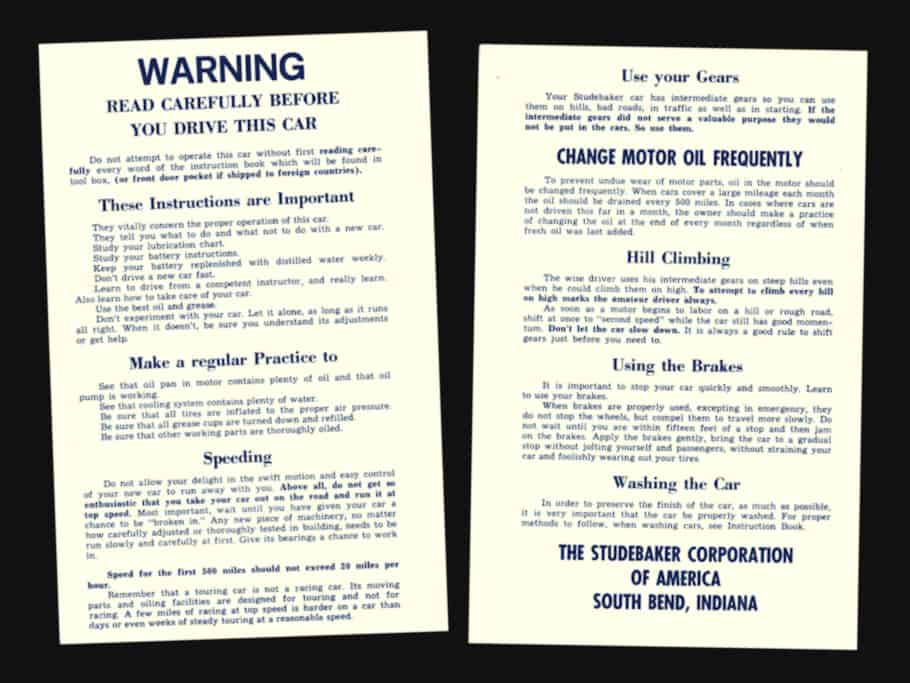
We admit we’re suckers for automotive ephemera. With a Studebaker in our fleet, this one is a favorite for the matter-of-fact tone and stern feel — it’s like getting lectured by my Grandfather, again…
If the intermediate gears did not serve a valuable purpose they would not be put in the cars. So use them.
Studebaker

WARNING
READ CAREFULLY BEFORE
YOU DRIVE THIS CAR
Do not attempt to operate this car without first reading carefully every word of the instruction book which will be found in tool box, (or front door pocket if shipped to foreign countries).
These Instructions are Important
They vitally concern the proper operation of this car.
They tell you what to do and what not to do with a new car.
Study your lubrication chart.
Study your battery instructions.
Keep your battery replenished with distilled water weekly.
Don’t drive a new car fast.
Learn to drive from a competent instructor, and really learn.
Also learn how to take care of your car.
Use the best oil and grease.
Don’t experiment with your car. Let it alone, as long as it runs all right. When it doesn’t, be sure you understand its adjustments or get help.
Make a regular Practice to
See that oil pan in motor contains plenty of oil and that oil pump is working.
See that cooling system contains plenty of water.
Be sure that all tires are inflated to the proper air pressure.
Be sure that all grease cups are turned down and refilled.
Be sure that other working parts are thoroughly oiled.
Speeding
Do not allow your delight in the swift motion and easy control of your new car to run away with you. Above all, do not get so enthusiastic that you take your car out on the road and run it at top speed. Most important, wait until you have given your car a chance to be “broken in.” Any new piece of machinery, no matter how carefully adjusted or thoroughly tested in building, needs to be run slowly and carefully at first. Give its bearings a chance to work in.
Speed for the first 500 miles should not exceed 20 miles per hour.
Remember that a touring car is not a racing car. Its moving parts and oiling facilities are designed for touring and not for racing. A few miles of racing at top speed is harder on a car than days or even weeks of steady touring at a reasonable speed.
Use your Gears
Your Studebaker car has intermediate gears so you can use them on hills, bad roads, in traffic as well as in starting. If the intermediate gears did not serve a valuable purpose they would not be put in the cars. So use them.
CHANGE MOTOR OIL FREQUENTLY
To prevent undue wear of motor parts, oil in the motor should be changed frequently. When cars cover a large mileage each month the oil should be drained every 500 miles. In cases where cars are not driven this far in a Month, the owner should make a practice of changing the oil at the end of every month regardless of when fresh oil was last added.
Hill Climbing
The wise driver uses his intermediate gears on steep hills even when he could climb them on high. To attempt to climb every hill on high marks the amateur driver always.
As soon as a motor begins to labor on a hill or rough road, shift at once to “second speed” while the car still has good momentum. Don’t let the car slow down. It is always a good rule to shift gears just before you need to.
Using the Brakes
It is important to stop your car quickly and smoothly. Learn to use your brakes.
When brakes are properly used, excepting in emergency, they do not stop the wheels, but compel them to travel more slowly. Do not wait until you are within fifteen feet of a stop and then jam on the brakes. Apply the brakes gently, bring the car to a gradual stop without jolting yourself and passengers, without straining your car and foolishly wearing out your tires.
Washing the Car
In order to preserve the finish of the car, as much as possible, it is very important that the car be properly washed. For proper methods to follow, when washing cars, see Instruction Book.




